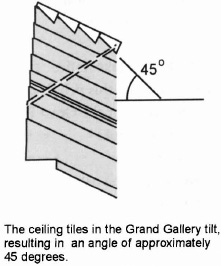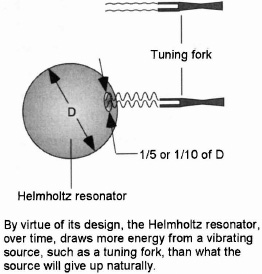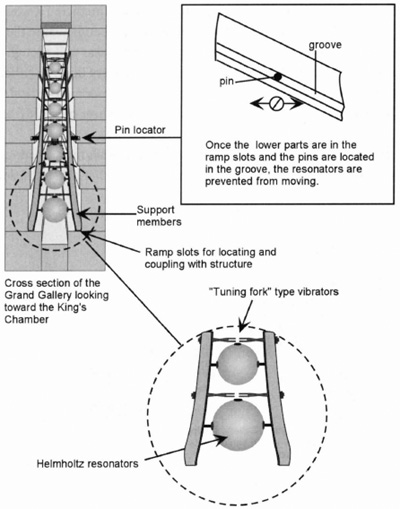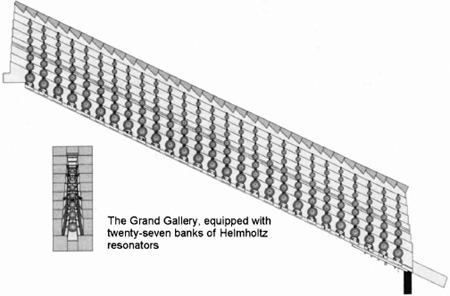The Giza Power Plant (25 page)
Another unique feature of the Grand Gallery, which needs to be confirmed by on-site inspection, is the approximate angle that is achieved by it having a ratchet-style ceiling. The problem with coming up with an accurate calculation of the true angle of the overlapping stones in this ceiling is that there is conflicting data from the only two researchers I have found who pay these overlaps any close attention. However, preliminary calculations are interesting to say the least. According to Smyth, the angle of the Grand Gallery is 26°17'37", the height of the Grand Gallery is between 333.9 inches and 346.0 inches, and he counted thirty-six overlaps in the 1,844.5-inchlength of the
ceiling.
9
Writing about his observations and measurements of the tilting tiles, Smyth said, ". . . when I was actually pushing up the point of a long measuring rod, against the roof stones, differences were found to so great an extent as 12.1 inches, which I did attribute chiefly to that very cause [that the tiles did indeed
tilt] ."
10
With the overlaps estimated to have approximately a twelve-inch tilt, the surface of the overlapping stones in the ceiling yields an amazing approximation to a 45-degree angle from a vertical plane (135 degrees polar coordinates, given that the ends of the gallery are 90 degrees). With this tilt of the roof tiles, a sound wave traveling vertically to the roof would be reflected off the tiles at a 90-degree angle and would travel in the direction of the King's Chamber (see Figure 39).
This gives pertinence to another report, which did not receive much
attention at the time it was made. It has been reported that Al Mamun's men had to break a false floor out of the Grand Gallery, and as they broke one stone out, another slid down in its place. This is a sketchy bit of information that would require further research, if further research is possible, because Al Mamun's men were tearing out so much limestone that little attention was given to this incident. However, what if that stone slid because the tiled floor in this gallery had a rachet style that matched the style of its ceiling? Much of the stone that Al Mamun cut out of the Ascending Passage was dropped down the Descending Passage. Later explorers, such as Caviglia, Davison, and Petrie, eventually cleared this passage of all debris, and most of this debris was dumped on the traditional rubbish pit on the north and east sides of the Great Pyramid. Petrie reported finding inside the Great Pyramid a prism-shaped stone that had a half-round groove running its length. In the Descending Passage he found a block of granite that was 20.6-inches thick with a tube-drilled hole cut through the thickness on one edge. Where this granite came from and what purpose it was used for in the Great Pyramid was a mystery to Petrie, who wrote, "What part of the Pyramid this can have come from is a puzzle; nothing like it, and no place for it, is
known."
11
With more significant findings attracting researchers' attention, though, it is not surprising these details were not given much consideration.

F
IGURE
39.
Roof Tiles of the Grand Gallery
It has been assumed that the rachet-style ceiling in the Grand Gallery was so designed to prevent an accumulation of forces bearing down the angle of the gallery and pressing on the lower pieces. Yet other angled passages in the Great Pyramid, such as the Ascending and Descending Passages, have flat ceilings, so I am left to conclude that this feature was, indeed, specifically designed for an acoustical purpose.
Even if some of the masonry clues are now lost to us, it may be possible
for an acoustical engineer to confirm that the Grand Gallery indeed reflected sound in the manner proposed by examining only its dimensions and angles. Perhaps this book will encourage an engineer to create a computer model of the Grand Gallery and perform an analysis by simulating the movement of sound within the cavity. Though I have attempted to find some means to accomplish this, I have not been able to find anybody with access to a supercomputer who is willing to do the work, and the software needed to perform the analysis has not, to my knowledge, been published for a microcomputer yet.
We can also extrapolate other information about acoustical devices that are obviously no longer in place within the Grand Gallery. Knowing that the King's Chamber will respond to sound of a specific frequency, thereby transducing that energy into electrical energy, I theorized earlier that the Grand Gallery housed resonators that converted the coupled Earth/pyramid vibration to airborne sound. The existence of resonators in this gallery is predicted by what has been found inside the King's Chamber and the design of, and phenomena noted in, the Grand Gallery. The mystery of the twenty-seven pairs of slots in the side ramps is logically explained if we theorize that each pair of slots contained a resonator assembly and the slots served to lock these assemblies into place. The original design of the resonators will always be open to question; however, if their function was to efficiently respond to the Earth's vibration, then we can surmise that they might be similar to a device we know of today that has a similar functionâa Helmholtz resonator.
A Helmholtz resonator responds to vibrations and actually maximizes the transfer of energy from the source of the vibrations. The resonator is normally made out of metal, but it can be ma4e out of other materials. A classic example of a Helmholtz resonator is a hollow sphere with a round opening that is 1/10 to 1/5 the diameter of the sphere. The size of the sphere determines the frequency at which it will resonate. If the resonant frequency of the resonator is in harmony with a vibrating source, such as a tuning fork, it will draw energy from the fork and resonate at greater amplitude than the fork is able to without its presence. It forces the fork to greater energy output than what is normal, or "loads" the fork. Unless the energy in the fork is replenished, its energy will be exhausted quicker than it normally would be without the Helmholtz resonator. But as long as the source
continues to vibrate, the resonator will continue to draw energy from it at a greater rate
(see Figure 40).
12

F
IGURE
40.
Helmholtz Resonator
To extrapolate further we could say that each resonator assembly that was installed in the Grand Gallery was equipped with several Helmholtz-type resonators that were tuned to different harmonic frequencies. In a series of harmonic steps, each resonator in the series responded at a higher frequency than the previous one. In a manner similar to the King's Chamber's response to energy inputsâits creation of an F-sharp chordâthese resonators raised the frequency of the vibrations coming from the Earth. To increase the resonators' frequency, the ancient scientists would have made the dimensions smaller, and correspondingly reduced the distance between the two walls adjacent to each resonator. In fact, the walls of the Grand Gallery actually step inward seven times in their height and most probably the resonators' supports reached almost to the ceiling. At their base, the resonators were anchored in the ramp slots. Not surprisingly, there is additional evidence in the Grand Gallery to support this premise, especially in a design feature of the gallery that is seldom given much thought. This is a groove, or slot, cut along the length of the second layer of the corbelled wall. This groove suggests the resonators were held in place inside the Grand Gallery and positioned, or keyed, into the structure by first being installed into the ramp slots and then held in a vertical position with "shot" pins in the groove. Once the resonator assemblies were positioned and locked into place, the angle of the slot effectively prevented them from moving (see Figure 41). The vertical supports for the Egyptian resonators were most likely made of wood because it is one of the most efficient responders to vibration; and, as we will discuss in chapter twelve, their disappearance from the pyramid can be easily explained. In crafting the resonators out of wood, the ancient Egyptians
made a natural and logical choice, as the wood probably emitted a humming sound itself.
Prior to my visit to Egypt in 1986, I had speculated that the slots along the Grand Gallery floor anchored wooden resonators, but that these devices were balanced in a vertical orientation reaching almost to the full height of the gallery. If this speculation were true, it would logically follow that the geometry of the twenty-seven pairs of slots would provide proof. The bottom of the slots might have been parallel to the horizontal plane rather than
parallel with the angle of the gallery, and the side walls of the slots might have been vertical to a horizontal plane rather than perpendicular to the angle of the gallery. This was a significant detail and a simple one to check out.

F
IGURE
41.
Design and Installation ofthe Resonators
My first trek inside the Great Pyramid in 1986 did not reveal anything about the geometry of these slots because they were filled with dirt and debris. The following day I set out with a soup spoon that I had "borrowed" from the hotel restaurant. Digging out the dirt and debris, with tourists and guides looking at me like I was crazy (actually, it was probably illegal to do this as you need special permission to carry out excavations in Egypt), I finally came to the bottom of one slot and it was as I predicted it would be: parallel to the horizontal, and the sides of the slot perpendicular to the horizontal. Other slots were perpendicular to the horizontal as well, though some of them had bottoms that were parallel with the gallery floor. In either scenario, it appears that the slots were prepared to accommodate a vertical structure, rather than to restrain weight that would exert shear pressure from the side (see Figure 42).
In attempting to determine the design and materials the resonators were made of, we must consider evidence from artifacts that are not inside the
pyramid but are housed within the Cairo Museum, where the most remarkable feats of machining in the world can be found. In the museum's collection are stone jars and bowls so finely machined and perfectly balanced that they inspire awe and wonder. One bowl in particular, a schist bowl with three lobes folded toward the center hub, is an incredible piece of work. If the artisans used ultrasonics and sophisticated machinery, I can understand how it
could have been made; but even if they used those methods, the purpose for creating such a complex piece, for what is assumed to have been a domestic purpose, has long escaped me (see Figure 43). Other vases with small necks that open into a wide round belly on the inside have confounded other researchers, such as Graham Hancock, who wrote, "During my travels in Egypt I had examined many stone vesselsâdating back in some cases to pre-dynastic timesâthat had been mysteriously hollowed out of a range of materials such as diorite, basalt, quartz crystal and metamorphic schist. For example, more than 30,000 such vessels had been found in the chambers beneath the Third Dynasty Step Pyramid of Zoser at Saqqara. That meant that they were at least as old as Zoser himself
(i.e. around 2650
BC
)."
13


